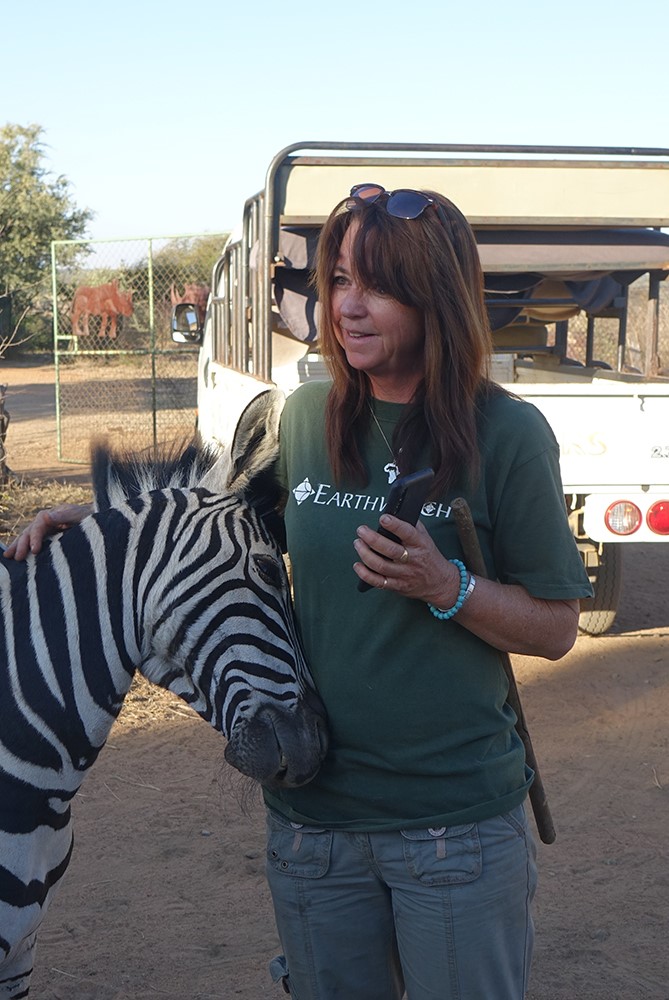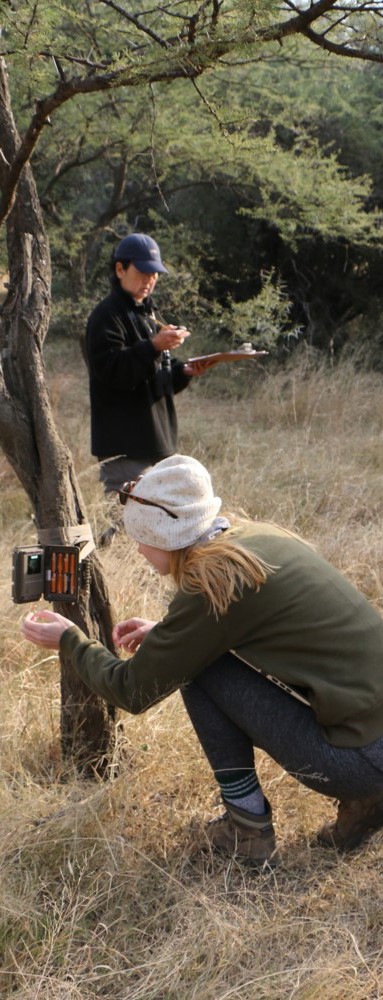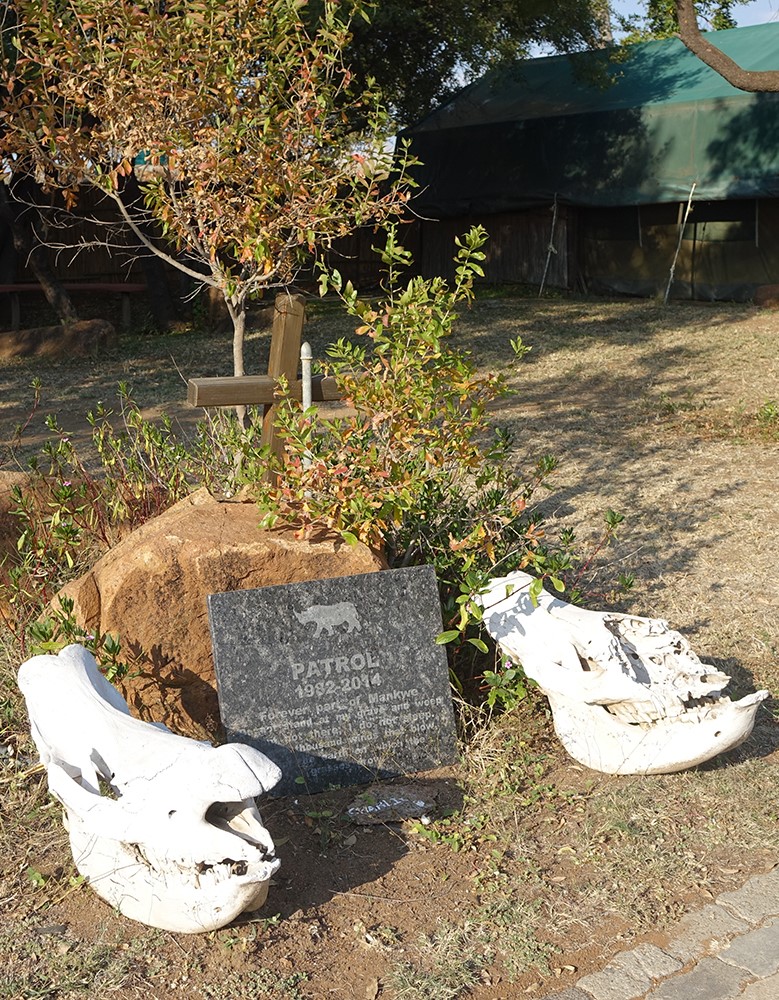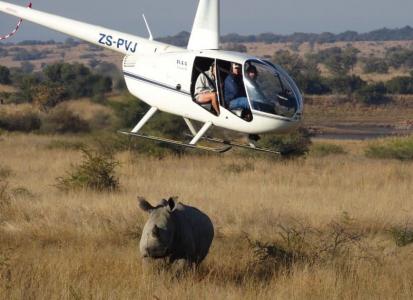.
Changing Faces
By Ashley Junger
.
With each of his blustering breaths my hair blew back. My fingers felt the full force of each exhale, while my palm rested on his trembling lip. Each huff was recorded twice. When I felt each breath, I called it out to Terri, a fellow Earthwatch volunteer, who held a timer to track each second. Rhinos should take between 8 to 10 breaths per minute. Terri and I knelt in the dusty brush of the South African savanna and counted each of Mac’s.
Mac didn’t know I was there. Between the sedative and the earplugs, he won’t know that I tickled his nose and tallied each huff. He won’t remember the dozens of people shouting around him, the sound of the generator rumbling, the feeling of the tape measure against his face and back, or the buzzing of a hand saw. For Mac, that day will end up being something like an unsettling but painless dream. For me, it was the most terrifying, yet thrilling day on the reserve. It was rhino horn-trimming day.
.
.
The Turning Point
Duiker, steenbok, eland, and reedbuck; the names of the various species of antelope are etched into wooden plaques, hung below a row of skulls, varying in completeness. They’re displayed on the walls of a small wood building on the edge of camp, known as the classroom. There, I—along with my fellow Earthwatch volunteers—sat on wooden benches, almost like pews, and heard Lynne MacTavish, the operations manager of the reserve and the co-PI of the Earthwatch expedition Conserving Endangered Rhinos in South Africa, tell us about the absolute worst day of her life.
In the warm dawn of October 10, 2014, during her usual patrol, Lynne came along a section of her fence line slashed open. Her heart dropped, and she immediately began searching for her rhinos. It didn’t take long for Lynne and her team to find the first two victims, one of which had been 17 months pregnant, dead, their faces mutilated and horns missing. That unimaginably dark day marked a turning point for Lynne and the reserve.
The poaching crisis had reached them, sweeping the reserve into a new era of struggle, loss, and fierce protection. Lynne vowed that the five rhinos who had died as a result of the poaching incident will not have died in vain. That their suffering would be a spark that fueled protections to keep the rest of their family safe.
“Through that very sad day, I found my greatest strength,” said Lynne, through tears.
Lynne began working to implement new security measures. She assembled a team of anti-poaching guards to patrol throughout the night in addition to the daily patrols staff had been doing. She adopted dogs and trained them to guard the reserve and work alongside the anti-poaching team. She worked with Earthwatch to launch a scientific research study that would help the team to better understand and protect these rhinos. But one of the most difficult decisions Lynne had to make after the poaching event was what to do about the rhinos’ horns.
Rhino horn has become one of the most valuable substances in the world. Some estimates price it at $32,500 per pound—more valuable than gold. An average adult white rhino carries a quarter of a million dollars, or more, on its face.
This value comes from the belief that rhino horn has medicinal properties—in South-Eastern Asian cultures, it is believed to cure everything from impotence to cancer. As rhino horns are made of keratin, the same protein as your nails and hair, it has no special properties. Yet, demand for the horn has remained high, leading to the death of thousands of rhinos.
Once poachers had struck the reserve, and knew that there were horned rhinos there, Lynne only had two options to protect her herd: transfer them to another reserve where they may be equally or more vulnerable to poaching, or remove the incentive for people to poach them, their horns. The decision was difficult, but Lynne was determined to fight and ensure that her reserve would be a haven for white rhinos.
“We never wanted to trim their horns,” said Lynne. “But when you’re staring into the face of one of your rhinos that’s been butchered by poachers, the decision to remove the horn that’s killing them is very, very simple.”
Today, Lynne stands in the cool shade of the classroom and shares the incredible pain and loss that shaped her life and home with each new group of volunteers. Through this story, she hopes to unveil the reality of rhino conservation, and reveal what that reality means for those fighting to keep them safe every day.
.
When you’re staring into the face of one of your rhinos that’s been butchered by poachers, the decision to remove the horn that’s killing them is very, very simple.
— Lynne Mactavish, the operations manager of the reserve and the co-PI of the Earthwatch expedition Conserving Endangered Rhinos in South Africa
.


.
Horn-Trimming Day
On a brisk June morning, Mac is disturbed from the brambling bushes and dry grass by the thwack of the helicopter blades and a loud beeping siren. The unusual noise scares him, provoking him into running across the sloping landscape of the South African savanna. As he moves, Lynne identifies him from the helicopter. Nico, the helicopter pilot, swings around, allowing Gerhardus, the wildlife vet, to send a single sedative-filled dart flying into his flank.
From the moment the dart makes contact with Mac, each second becomes precious—we have only 20 minutes before we need to wake him up. His location is radioed to a caravan of waiting volunteers. The line of white trucks careen off the road and race over the bumpy brush.
When the volunteers arrive, Mac is drowsy. He high-steps and walks slowly. The team of first-responders immediately jumps into action. They walk alongside him, pushing to guide him and making sure he doesn’t hurt himself as he falls down.
Once he’s down, his ears are plugged to keep the noises from disturbing his sleep and his eyes are covered with a towel to keep him calm if he wakes up during the trimming. Then the breathing team is sent in. Today, it is Terri and me. We take turns resting our hands on the opening of his nostril and counting his breaths, ready to alert the vet if they became too fast or too slow.
Touching Mac didn’t feel how I expected. His skin is dry and rough, but he was softer than I thought, especially behind his ears. His head was bigger than my entire body. Kneeling by him and feeling each shudder was electrifying. It was hard to balance the curiosity of being so close to a three-ton animal with the anxiety of sitting in the middle of the organized chaos unfolding around us.
While the horn trimming itself is rather short, pulling it off is an immense undertaking. Besides coordinating a helicopter pilot and a wildlife vet, Lynne had to get permits and ensure government officials came to oversee the proceedings. On top of that, dozens of volunteers – Earthwatch and otherwise—showed up to help maneuver, measure, distribute supplies, monitor vitals, and offer support on one of the rhino’s most vulnerable days.
As we sit and feel Mac breathe, Gerhardus rushes over and, without preamble, begins to trim Mac’s horn. He uses a small electrical saw and cuts a few inches from the base.
.
“It’s just like clipping your nails,” said Gerhardus.
Just like our nails, there’s a growth plate, beyond which you can trim away the dead cells. When you’re done clipping your nails, you still have fingernails; just as rhinos still have horns after they’re trimmed. They’re just much shorter.
Terri and I turn our heads and cover our mouths as small flecks of horn rain on us. It only takes a few minutes for Gerhardus to cut through, and the small mound is handed off to be guarded until it can be cataloged and put in a vault by Lynne. Gerhardus finishes off by sanding down the edges of Mac’s horn to prevent any injuries from the sharp edges.
After the vitamin shots are given, measurements taken, and the horn trimmed, the volunteers scurry back to their vehicles and the rhino receives a stimulant to wake up. After just a few moments, Mac stands up. He stops to stare at the trucks full of people for just a few moments, then he trots off behind some trees. At first, he’s groggy, but after 10 minutes, he appears to be completely back to normal.
For many of the volunteers, this was their first time being involved in a horn-trimming effort. The excitement and anxiety for the day left everyone elated by the end of the event. Four rhinos were successfully horn-trimmed. They were enormously safer that night than they had been in the morning.
Rhinos are living dinosaurs. They have faced 20 million years of threats. They have survived in worlds we will never truly understand, but they are resilient, and their populations have persisted. They are a unique and spectacular holdover - an evolutionary keepsake.
“If they die out, there’s nothing else on the planet like them,” said Gerhardus.
But can they survive us?
.
If they die out, there’s nothing else on the planet like them.
.
.
The Poaching Crisis
I never thought I’d be excited to have someone else’s snot on my hands. But at the end of the day, as I washed the last traces of Mac from underneath my fingernails, all I felt was gratitude. I was very lucky to have the chance to be so close to and to touch an animal that is rapidly disappearing. Many predict that rhinos will be extinct in the next 10 years, and it seems increasingly likely that these magnificent creatures will become a bittersweet memory.
The world has already lost nearly 95 percent of its rhinos in the last 116 years. Just last year, the last male northern white rhino, Sudan, died. Of the five extant rhino species, three are classified as critically endangered. Each day, there are fewer and fewer rhinos than there was the day before.
South Africa is home to nearly 80 percent of the world’s remaining wild rhinos, and in the last decade, poaching there has risen over 8,000 percent. An estimated 7,700 rhinos lost their lives to poaching in just a decade—that’s nearly 40 percent of the current population.
.


Of the remaining 18,000 white rhinos in South Africa, 45 percent reside on private reserves, like the one Mac lives on. Increasingly, these reserves are implementing horn-trimming as a defense against poaching. “It’s a preventative measure,” said Gerhardus.
Poachers are much less likely to target rhinos whose horns have been trimmed—the smaller payoff likely doesn’t outweigh the risk to their lives and freedom. Not to say that horn-trimmed rhinos are never poached; it may be hard to tell a rhino is horn-trimmed at night, when most poaching takes place, or they may be killed to prevent trackers wasting time on them, or poachers may be satisfied with the small amount of horn that remains.
However, many reserves are finding horn-trimming to be a particularly effective part of an anti-poaching plan. Lynne’s reserve hasn’t had a rhino poaching incident since they started trimming their rhinos’ horns nearly five years ago. Meanwhile, in nearby Pilanesberg National Park, which contains horned rhinos, multiple rhinos are being poached each week. Gerhardus recounts several other reserves where rhino poaching virtually halted after he began trimming their rhinos’ horns.
Many reserve owners don’t currently horn-trim because the process is very expensive—it can cost approximately $1,000 per rhino each year, and other anti-poaching measures are already draining their resources. But many reserve owners, and conservationists, also worry about how trimming the rhinos’ horns affects their behavior. Does a rhino still act like a rhino without a horn?
The first thing you feel when you see a rhinos’ sharp soaring horn is probably intimidation, and that’s by design. More than anything else, a rhino’s horn is meant to scare others off. Whether it’s a rival bull, encroaching animals, or a male getting a little too cheeky, these huge protrusions serve as a warning: back off…or else.
But if showing off the horn doesn’t work, rhinos will use it to fight. Thanks to their massive stature, rhinos face very little predation in the wild— although predators will try to snatch away young rhinos when they wander too far from mom—so much of the time if a rhino is using their horn to fight, it’s against another rhino. Whether over mates or territory, rhinos will lock horns with each other, often resulting in serious or mortal wounds.
This defense mechanism developed and persisted over millions of years. Now, it’s being removed, and reserve owners, including, Lynne, want to know what effect horn trimming has on the behavior of white rhinos. What are the implications for the mating, defense, and social structures of rhino populations?
That’s where Melissa Dawson, an Earthwatch field team leader and doctoral candidate at the University of Brighton, comes in. Melissa began working on the reserve right before the 2014 poaching incident.
“Immediately, this place and the rhinos became very, very important to me,” said Melissa.
Melissa has been leading teams of Earthwatch volunteers through shrubs and thickets to collect data on how horn-trimming is affecting the reserve’s rhinos. Her first aim was to determine the impact of horn-trimming on rhino physiology, behavior, and ecology. For the past four years, Earthwatch volunteers from around the world have been traveling to South Africa to help Melissa observe the rhinos’ behavior and collect fecal samples.
Thanks to this data, Melissa has found that while rhinos experience elevated stress on the day of the horn-trimming, that stress recedes fairly quickly, and the rhino’s behavior is not significantly impacted after horn-trimmings. “The research that Earthwatch is doing is phenomenal because it’s showing scientifically, factually, that the horn-trimming is not having a detrimental effect on the rhino,” said Melissa.
Now, Melissa is focusing on determining what factors affect the distribution of rhinos on the reserve—where they hang out and why. I, along with my team, helped Melissa in this goal. We roamed the reserve, recording where we spotted rhinos, and spent hours observing their behavior. Were they walking? Foraging? How often were they vigilant to us? To other animals? All of this data helps Melissa to determine where rhinos like to spend their time and how they use those areas while they’re there. Melissa hopes that this information can be used to predict where rhinos will be, allowing managers and anti-poaching teams to better protect rhino populations.
All of the data Melissa is collecting helps Lynne and her team better manage the reserve in real-time. It informs and scientifically backs the policies and procedures they’re using. While the rhino’s experience on Lynne’s reserve isn’t universal—it doesn’t contain large predators and is small compared to some other parks—it helps better inform everyone who manages rhinos of the realities of these under-studied creatures and the effects different management techniques can have.
“What’s really important to me, which Earthwatch has done really well, is make sure the research that’s going on has an effect on the ground,” said Melissa. “The science is absolutely essential to ensure that the policies and management techniques you’re using are safe.”
.
.
Securing a Future for the White Rhino
A red brick path winds through the reserve’s camp, past the classroom and cabins. Beside this path, in the short grass, are two rhino skulls. Between them is a black marble plaque, commemorating Patrol, one of the rhinos lost to the poaching event in 2014. Through the hustle and bustle of everyday life, the small memorial serves as a reminder of what’s at stake.
Lynne and Melissa seem to have found an uneasy ceasefire with the poaching crisis raging around them, but this shaky success relies on vigilant efforts to protect the rhinos.
“Rhino conservation has become my life,” said Lynne. “You’re never off duty.”
From coordinating patrol teams to scheduling teams of volunteers to sleeping with a change of clothes and supplies next to her bed, just in case she gets that dreaded call in the middle of the night, every spare resource and minute goes towards protecting the rhinos.
All this effort comes at a high price. “The cost of anti-poaching is not sustainable,” said Lynne. Most of the reserve’s money goes towards anti-poaching efforts, like the night patrol team and dogs, trimming the rhinos’ horns, and maintaining the perimeter fence. They can’t afford the improvements and maintenance that were a priority a decade ago. Finding a way to absorb the huge and urgent cost of protecting the rhino has put a strain not only on Lynne and her reserve, but all private reserves, leaving the future of some 9,000 rhinos uncertain.
“A lot of private reserves are giving up on their rhino,” Lynne said. “They are physically, emotionally, and financially drained and they are giving up on the rhino.”
Lynne sees this as a problem of economics. There is huge value in a dead, poached rhino, but almost none in conserving the species. In fact, rhinos have become such a guaranteed bad investment, reserve owners who have gone bankrupt have a difficult time finding someone to take in their rhinos.
Many rhino conservation efforts have focused on demand reduction, educating the people consuming rhino horn and prosecuting those who possess it. However, Lynne is skeptical that this strategy alone will ever be able to solve the poaching crisis. The belief that rhino horn holds medicinal powers is thousands of years old, and at most, we have a decade or two to eliminate that demand.
“We have to fight economics with economics,” said Lynne. “I believe the only way we’re going to save the rhino from extinction is to legalize the trade in rhino horn internationally.”
By creating a market where only those protecting rhinos, reserve and farm owners, can internationally trade rhino horn harvested from horn-trimming with Asian markets, Lynne believes a system can be created where it becomes more valuable to conserve and protect rhinos than to poach them. The thing that’s killing them, could become the key to their future.
“Unless we are able to sell the horns, we will become a statistic like the other 30 private reserves that closed this year. And so will a lot of other people,” said Lynne.
The idea of legalizing international horn trade is highly controversial. Besides logistical issues, many worry about increasing demand for rhino horn and bad actors abusing the system. Attempts to open up trade of ivory and rhino horn have gone poorly in the past, due to a variety of factors. Profiting off an endangered or threatened species often results in an immediate negative reaction from most people, but Lynne wants people to go deeper than their initial reaction and consider the position she and her fellow reserve owners are in.
“Sometimes it feels like we’re fighting the poachers, but we’re also fighting the activists,” said Lynne. “It’s very difficult to understand what we face every day until you’ve walked in our shoes.”
Lynne doesn’t view this as a perfect solution. If she had a choice, she’d have rhinos that could roam without protection, sporting their magnificent horns. But she’s learned through personal experience that if you don’t trim the horns, rhinos get poached, and if you don’t spend the money for anti-poaching teams and other protections, rhinos get poached. And if you spend the money to protect and horn-trim, you go bankrupt. Given these factors, Lynne sees legalizing trade as the only workable solution that creates a secure future for the private reserves guarding almost half of South Africa’s rhinos. To save the rhino we have to make the living, breathing rhino more valuable than a dead rhino.
“If we want this species to survive, if we want our children, our grandchildren, to see this magnificent animal, we need to do something about it and work together to bring this species back from the brink of extinction,” said Melissa.
As a more eco-conscious, less culturally tied generation comes to the forefront, celebrities speak out against horn consumption, and mindsets on conservation shift, many are hopeful that the demand for rhino horn can be significantly reduced or even eliminated. Whether it’s ivory, shark fins, or even plastic straws, more and more people are beginning to recognize the consequences of their lifestyles and take measures to correct them.
While this shift towards a global eco-consciousness is essential to combat some of the greatest environmental threats the world has faced, Lynne, and many rhino conservationists, worry that waiting on the new attitudes of a new generation will be too late. The rhinos are dying now, every day, and they don’t have the decades it will take to shift attitudes and phase out the demand.
While the pros and cons of legalizing trade, decreasing demand, and horn-trimming are debated and studied, analyzed and action-planned, rhinos are dying. Lynne and her rhinos need our help now. They need our help as they observe the rhinos’ behavior, monitor their stress, and trim their horns. Time is running out for the white rhino, but if we take action now, it’s not too late.
.



.
Join Us
Join Lynne and Melissa to conserve and study these magnificent creatures by signing up for the expedition Conserving Endangered Rhinos in South Africa today!
.
.
Thanks for reading! Please share any questions or comments related to this article by emailing us at communications@earthwatch.org.
.
Sign up for the Earthwatch Newsletter
Be the first to know about new expeditions, stories from the field, and exciting Earthwatch news.
